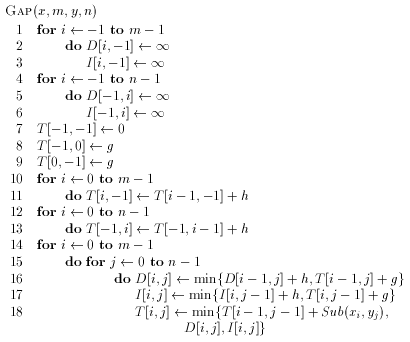It is possible to penalize the length of the gaps instead of
penalizing the deletion or the insertion of individual letters.
Let us use a function
![]() .
.
![]() indicates the cost of a gap of length k.
In this case the computation of an optimal alignment is done using
the following recurrence formula:
indicates the cost of a gap of length k.
In this case the computation of an optimal alignment is done using
the following recurrence formula:

D(i,j) indicates the score of an optimal alignment
between
x0x1···xi
and
y0y1···yj
ending with deletions of letters of x.
I(i,j) indicates the score of an optimal alignment
between
x0x1···xi
and
y0y1···yj
ending with insertions of letters of y.
T[i,j] indicates the score of an optimal alignment
between
x0x1···xi
and
y0y1···yj.
Without restriction on the function
![]() the problem can be solve in O(mn(m+n))
time.
the problem can be solve in O(mn(m+n))
time.
If the function
![]() is affine:
is affine:
![]() which corresponds to penalize the opening of a
gap with g and widening a gap is penalized with h then
the problem can be solve in O(mn) time
([7]):
which corresponds to penalize the opening of a
gap with g and widening a gap is penalized with h then
the problem can be solve in O(mn) time
([7]):


It is easy to see that the tables D, I and T can be reduce to a linear size if only the value of T[m-1,n-1] is needed.
To exhibit an alignment a forth quadratic table has to be used to store in each square which neighbour has served to compute its value (same row and previous column, previous row same column or previous row previous column). Only three different values are possible thus only two bits are enough per square. If all the optimal alignments are to be computed then three bits are required.
Example :
x = YHCQPGK,
y = LAHYQQKPGKA,
Sub(a,a) = 0,
Sub(a,b) = 3,
g = 3 and
h = 1.



We get the three following optimal alignments:
![]()
![]()
![]()